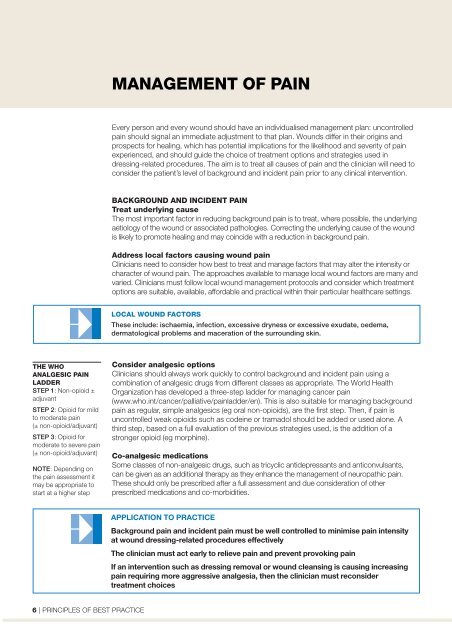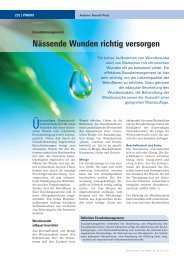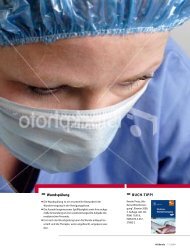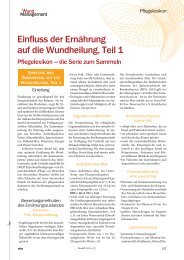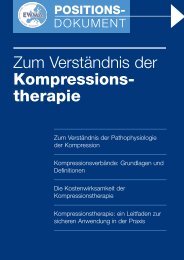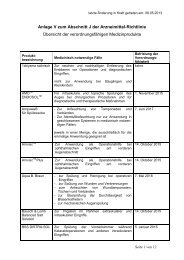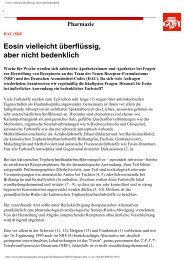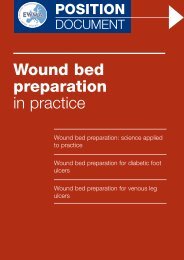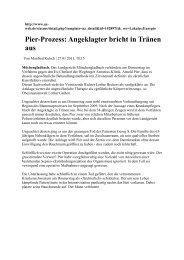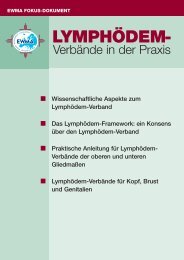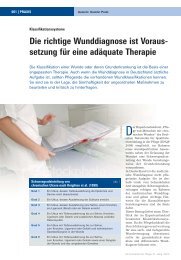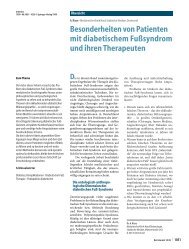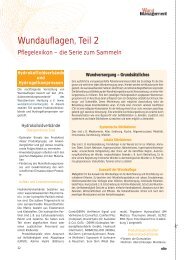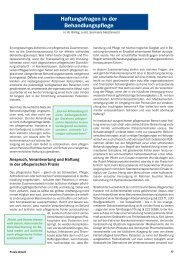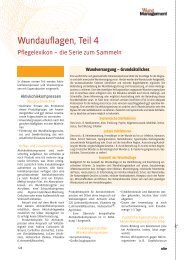Minimising pain at wound dressing-related procedures A ... - Less Pain
Minimising pain at wound dressing-related procedures A ... - Less Pain
Minimising pain at wound dressing-related procedures A ... - Less Pain
You also want an ePaper? Increase the reach of your titles
YUMPU automatically turns print PDFs into web optimized ePapers that Google loves.
MANAGEMENT OF PAIN<br />
Every person and every <strong>wound</strong> should have an individualised management plan: uncontrolled<br />
<strong>pain</strong> should signal an immedi<strong>at</strong>e adjustment to th<strong>at</strong> plan. Wounds differ in their origins and<br />
prospects for healing, which has potential implic<strong>at</strong>ions for the likelihood and severity of <strong>pain</strong><br />
experienced, and should guide the choice of tre<strong>at</strong>ment options and str<strong>at</strong>egies used in<br />
<strong>dressing</strong>-rel<strong>at</strong>ed <strong>procedures</strong>. The aim is to tre<strong>at</strong> all causes of <strong>pain</strong> and the clinician will need to<br />
consider the p<strong>at</strong>ient’s level of background and incident <strong>pain</strong> prior to any clinical intervention.<br />
BACKGROUND AND INCIDENT PAIN<br />
Tre<strong>at</strong> underlying cause<br />
The most important factor in reducing background <strong>pain</strong> is to tre<strong>at</strong>, where possible, the underlying<br />
aetiology of the <strong>wound</strong> or associ<strong>at</strong>ed p<strong>at</strong>hologies. Correcting the underlying cause of the <strong>wound</strong><br />
is likely to promote healing and may coincide with a reduction in background <strong>pain</strong>.<br />
Address local factors causing <strong>wound</strong> <strong>pain</strong><br />
Clinicians need to consider how best to tre<strong>at</strong> and manage factors th<strong>at</strong> may alter the intensity or<br />
character of <strong>wound</strong> <strong>pain</strong>. The approaches available to manage local <strong>wound</strong> factors are many and<br />
varied. Clinicians must follow local <strong>wound</strong> management protocols and consider which tre<strong>at</strong>ment<br />
options are suitable, available, affordable and practical within their particular healthcare settings.<br />
LOCAL WOUND FACTORS<br />
These include: ischaemia, infection, excessive dryness or excessive exud<strong>at</strong>e, oedema,<br />
derm<strong>at</strong>ological problems and macer<strong>at</strong>ion of the surrounding skin.<br />
THE WHO<br />
ANALGESIC PAIN<br />
LADDER<br />
STEP 1: Non-opioid ±<br />
adjuvant<br />
STEP 2: Opioid for mild<br />
to moder<strong>at</strong>e <strong>pain</strong><br />
(± non-opioid/adjuvant)<br />
STEP 3: Opioid for<br />
moder<strong>at</strong>e to severe <strong>pain</strong><br />
(± non-opioid/adjuvant)<br />
NOTE: Depending on<br />
the <strong>pain</strong> assessment it<br />
may be appropri<strong>at</strong>e to<br />
start <strong>at</strong> a higher step<br />
Consider analgesic options<br />
Clinicians should always work quickly to control background and incident <strong>pain</strong> using a<br />
combin<strong>at</strong>ion of analgesic drugs from different classes as appropri<strong>at</strong>e. The World Health<br />
Organiz<strong>at</strong>ion has developed a three-step ladder for managing cancer <strong>pain</strong><br />
(www.who.int/cancer/palli<strong>at</strong>ive/<strong>pain</strong>ladder/en). This is also suitable for managing background<br />
<strong>pain</strong> as regular, simple analgesics (eg oral non-opioids), are the first step. Then, if <strong>pain</strong> is<br />
uncontrolled weak opioids such as codeine or tramadol should be added or used alone. A<br />
third step, based on a full evalu<strong>at</strong>ion of the previous str<strong>at</strong>egies used, is the addition of a<br />
stronger opioid (eg morphine).<br />
Co-analgesic medic<strong>at</strong>ions<br />
Some classes of non-analgesic drugs, such as tricyclic antidepressants and anticonvulsants,<br />
can be given as an additional therapy as they enhance the management of neurop<strong>at</strong>hic <strong>pain</strong>.<br />
These should only be prescribed after a full assessment and due consider<strong>at</strong>ion of other<br />
prescribed medic<strong>at</strong>ions and co-morbidities.<br />
APPLICATION TO PRACTICE<br />
Background <strong>pain</strong> and incident <strong>pain</strong> must be well controlled to minimise <strong>pain</strong> intensity<br />
<strong>at</strong> <strong>wound</strong> <strong>dressing</strong>-rel<strong>at</strong>ed <strong>procedures</strong> effectively<br />
The clinician must act early to relieve <strong>pain</strong> and prevent provoking <strong>pain</strong><br />
If an intervention such as <strong>dressing</strong> removal or <strong>wound</strong> cleansing is causing increasing<br />
<strong>pain</strong> requiring more aggressive analgesia, then the clinician must reconsider<br />
tre<strong>at</strong>ment choices<br />
6 | PRINCIPLES OF BEST PRACTICE


